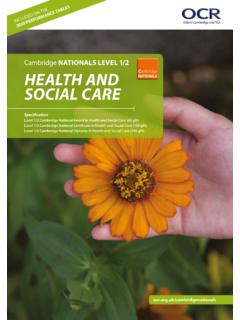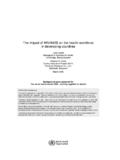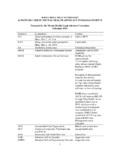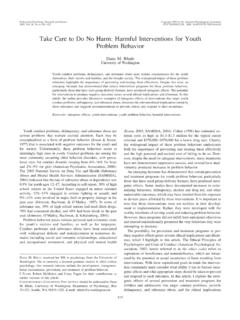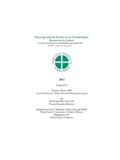Transcription of Sri Lanka:'Good Practice' in Expanding Health Care Coverage
1 Sri Lanka: good Practice in ExpandingHealth care CoverageResearch Studies Series 3 Ravi P. Rannan-EliyaLankani SikurajapathySri Lanka: good Practice in Expanding Health care CoverageRavi P. Rannan-Eliya and Lankani Sikurajapathy2009ii 2009 The International Bank for Reconstruction and Development / The World Bank1818 H Street NWWashington DC 20433 Telephone: 202-473-1000 Internet: : rights reservedThe findings, interpretations, and conclusions expressed herein are those of the author(s) and do not necessarily reflect the views of the Executive Directors of the International Bank for Reconstruction and Development / The World Bank or the governments they World Bank does not guarantee the accuracy of the data included in this work. The boundaries, colors, denominations, and other information shown on any map in this work do not imply any judg-ment on the part of The World Bank concerning the legal status of any territory or the endorsement or acceptance of such and PermissionsThe text of this publication is reproduced by kind permission of the Office of the Publisher, The World Bank.
2 The material in this publication is copyrighted. Copying and/or transmitting portions or all of this work without permission may be a violation of applicable law. The International Bank for Reconstruc-tion and Development / The World Bank encourages dissemination of its work and will normally grant permission to reproduce portions of the work promptly. For permission to photocopy or reprint any part of this work, please send a request with complete information to the Copyright Clearance Center Inc., 222 Rosewood Drive, Danvers, MA 01923, USA; telephone: 978-750-8400; fax: 978-750-4470 (in-ternet: ).All other queries on rights and licenses, including subsidiary rights, should be addressed to the Office of the Publisher, The World Bank, 1818 H Street NW, Washington, DC 20433, USA; fax: 202-522-2422; e-mail: ISBN-10, and CIP data]National Library of Sri Lanka Cataloguing in Publication DataRannan-Eliya, Ravi P. Sri Lanka: good Practice in Expanding Health care Coverage / Ravi P.
3 Rannan-Eliya and Lankani Sikurajapathy. Colombo: Institute for Health Policy, 2009. 38p: ill ; ISBN 978-955-1707-06-4 i. DDC 21 ii. Title iii. Sikurajapathy, Lankani - jt. au 1. Health care - research 2. Health care - Sri Lanka Suggested Citation:Rannan-Eliya, Ravi P., and Lankani Sikurajapathy. 2008. Sri Lanka: good Practice in Expanding Health care Coverage . Research Studies Series, Number 3, Colombo, Institute for Health Policy. iiiInstitute for Health PolicyThe Institute for Health Policy (IHP) is an independent research institution, and a regional centre of excellence for Health policy research, working to improve Health and social systems in Sri Lanka and the wider region, by supporting, encouraging and informing policy change, through quality research, analysis and training. Consistent with the Institute s mission, we intend that as much of our research as possible is widely accessible, with the intention of stimulating discussion and comment, and to inform a wider audience of ongoing IHP research.
4 We do this primarily by making most of our publications available online for free download via the IHP website ( ). About the AuthorRavi P. Rannan-Eliya is a physician and economist, who graduated from the University of Cambridge with degrees in political science and medicine. After his medical internship in the United Kingdom, he specialized in international public Health , earning a Master s degree in public Health and then his doctoral degree in Health economics from Harvard University. From 1993 to 1997, he was a member of the re-search faculty at Harvard University, where he worked on a series of research projects in Latin America, Africa, and Asia. From 1997, he established and developed the leading Health economics research group in Sri Lanka, which became the Institute for Health Policy in 2005. He has undertaken research and consulted in more than 30 countries, working with the World Bank, WHO, ADB and other agencies and Sikurajapathy was a research assistant at the Institute for Health Policy at the time of writing and now works for UNFPA in Sri Lanka.
5 She graduated with a degree in sociology with social policy from University of Warwick, before completing a Master s degree in comparative social policy at the Univer-sity of Oxford. While at IHP, she worked on a number of projects related to Health systems financing and development of district Health performance indicators. vContentsAcknowledgements viiiForeword ixAcronyms xAbstract 1 CHAPTER 1: Background 2 Economic Environment 2 Demography and Health 3 Government and Politics 5 CHAPTER 2: Health Financing and Coverage 7 Health Expenditures 7 Use of expenditures 7 Benefit-incidence of government Health expenditures 8 Incidence of financing 8 Protection against catastrophic risk 9 Benefits Package 9 Financing and Payment 10 Development of Health Financing 11 Equity- Health Indicators, Outcomes, and Their Distribution 12 Targeting and equity implications of reforms 13 Efficiency 16 Technical efficiency at the macrolevel 16 Technical efficiency at the microlevel 17 Allocational efficiency 17 CHAPTER 3.
6 Health Delivery System 19 Health Services Organization 19 Growth of Health Service Provision 20 Medical Education and Regulation 20 Pharmaceuticals and Medical Technology 21 Pharmaceutical supply and regulation 21 Medical technology 21 Strengths and Weaknesses 22 CHAPTER 4: Health Coverage Reforms 23 The Precursors to Sri Lanka s Health Reforms 23 A history of state intervention 23 Exposure to western medicine 23 The colonial state and introduction of democracy 24 The lessons of market failure in the Health sector 24 Health System Reforms 25 Abolition of user fees 26 The emphasis on hospitals 26 Indigenization of medical department 26 Tradeoff of quality versus access 26 Productivity improvement 26 Compulsory posting and dual medical practice 27 Evaluation of Reforms 27vi Institutional change 28 Health outcomes 28 Cost implications of scaling up and targeting 28 Politics and sustainability 29 Key Conditions 29 CHAPTER 5.
7 Lessons for Other Countries 30 Democratic accountability can ensure that Health systems are responsive to the needs of the poor 30 Fair access for all should be a priority goal of Health systems 30 Health systems must provide the poor with insurance against catastrophic illness 30 Efficiency in Health service production is more important than resource mobilization in overcoming resource constraints 30 Pessimism about the relative inefficiency of public sector Health service production is as unwarranted empirically as it is theoretically 31 Cost-effectiveness of interventions and a disease-focused approach to allocational efficiency are irrational and inefficient guides to resource allocation and may lead to erroneous use of resources 31 Use of consumer quality differentials in a dual public-private system can be a more effective mechanism of targeting Health subsidies than explicit targeting 31 Endnotes 33 References 35viiTablesTable 1 Sri Lanka: Economic indicators, 1930-2005 3 Table 2 Sri Lanka: social indicators, 1930-2005 3 Table 3 Sri Lanka: Demographic and Health indicators, 1930-2003 4 Table 4 Sri Lanka: Leading causes of mortality, 2001 6 Table 5 Sri Lanka: Patient morbidity, inpatients and outpatients 6 Table 6 Sri Lanka: Trends in Health care spending, 1953-2005 7 Table 7 Sri Lanka: Incidence of public Health expenditures, 1979-2004 8 Table 8 Sri Lanka: Progressivity of Health financing compared with selected asian countries 9 Table 9 Sri Lanka: Proportion of population pushed below the PPP$ poverty line by household Health spending, compared with selected asian countries 10 Table 10 Sri Lanka: Infant mortality rates in different social groups, 1920-22 12 Table 11 Sri Lanka: Infant mortality rate, selected districts, 1921-2000 13 Table 12 Sri Lanka.
8 Health services use and spending, compared with selected comparable countries 17 Table 13 Sri Lanka: Technical efficiency in public hospitals, compared with selected countries 18 Table 14 Sri Lanka: Proportion of MOH expenditures devoted to hospitals (percent) 18 Table 15 Sri Lanka: Provision of Health service inputs and activities, 2003 19 Table 16 Sri Lanka: Trends in treatment sources used by sick persons, 1978-2004 (percent) 19 Table 17 Sri Lanka: The chronology of scaling-up Health reforms 22 Table 18 Sri Lanka: Expansion of Health service Coverage , 1931-1951 28 FiguresFigure 1 Sri Lanka: Population Pyramids 1991, 2006, 2026, and 2051 5 Figure 2 Sri Lanka: Government recurrent Health spending, 1927-2005 11 Figure 3 Sri Lanka: Differentials in infant mortality rate, by Asset Quintile, 1987-2000 14 Figure 4 Sri Lanka: Differentials in medical attendance at childbirth, by Asset Quintile, 1987-2000 14 Figure 5 Sri Lanka: Differentials in use of modern methods of contraception by currently married women, 1987-2000 15 Figure 6 Sri Lanka: Trends in infant mortality rates, Country and Nuwara Eliya District, 1920-2003 16 Figure 7 Sri Lanka: Government hospital provision, 1920-2000 20 Annex TablesAnnex Table 1 Sri Lanka: Total Health expenditures, 1993-2005 34 Annex Table 2 Sri Lanka: Health expenditures, by source, 1993-2005 (percent of total) 34 Annex Table 3 Sri Lanka: Health expenditures, by provider, 1993-2005 (percentage of total) 34viiiAcknowledgementsAny opinions expressed, or recommendations made in this report are those of the authors alone, and not necessarily those of the Institute for Health Policy or the World Bank.
9 The editing of the first draft by Neluka Silva is gratefully acknowledged. ixForewordWith Health at the center of global development policy, developing countries and the international community are focused on scaling up Health systems, in line with the Millennium Development Goals (MDGs). As a result, both global aid and individual country Health reform plans are trained on improv-ing Health outcomes, securing financial protection against impoverishment, and ensuring long-term, sustainable financing to support these gains. However, despite the scaling up of aid, both countries and donors have begun to appreciate that money alone will not be sufficient, and that many of the most suc-cessful Health performers have managed with minimal financial resources. How these good Health performers have achieved their success has remained unclear and lacking in consensus. Recognizing this, the World Bank undertook a major global study of countries that are con-sidered to have been exceptional successes.
10 Success in this respect was defined as demonstrated good performance in Expanding their populations access to healthcare Coverage , and in improving Health status and protecting against catastrophic medical expenses. good performance included average or better-than-average population Health outcomes relative to resources devoted to Health and to national income and educational the low- and middle-income countries that were determined by the World Bank to be in the pro-cess of achieving high levels of population Coverage and financial protection, nine were selected as ex-amples of good performance by an expert steering committee representing all six World Bank Regions. They are Chile, Colombia, Costa Rica, Estonia, the Kyrgyz Republic, Sri Lanka, Thailand, Tunisia, and Vietnam. Each of these countries were then studied using a case-study approach, anchored in a system-atic comparative framework that was designed to identify common factors and explanations.


